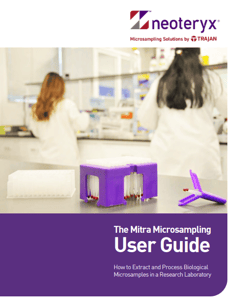microsampling in preclinical research
Discover microsampling devices that offer precise, low-volume sampling for less impact on study animals.
Achieve the 3Rs of ethical research. Improve efficiencies. Generate accurate data.
Explore our microsampling resources below...
Your Microsampling Advantages
Reduce the number of animals used in a preclinical study | Reuse animals multiple times by collecting smaller volume samples
Refine methods with microsampling to minimize pain or distress
Frequently Asked Questions (FAQs)
Preclinical researchers use microsampling to help refine their blood collection techniques in an effort to use a less invasive method on all animal laboratory species. Microsampling blood collection methods can be used with mice and other species including rats and other rodents, dogs and non-human primates for toxicokinetic evaluations.
Microsampling improves animal welfare programs and reinforces the principles of the 3Rs: Replace, Reduce, Refine. Labs can refine their microsampling methods to reduce the number of mice they use in toxicology studies and toxicokinetic evaluations. For example, you can perform a series of micro-sized blood collections on the same mouse with less impact vs. more invasive sampling methods that only allow you to collect 1-2 time points per animal.
To achieve the principles of the 3Rs in animal research, including better animal safety and lowered stress on animals. Other top drivers include greater data consistency and cost savings.
A primary barrier can be that a lab's clients performed their bioanalytical validation prior to their in-vivo studies with a different type of technique (e.g., wet blood in tubes) and they do not want to run another validation or develop a new method of analysis to adopt a new collection device or to switch to a dry matrix technique during their project development. To help overcome this barrier, Neoteryx provides technical advice on using dried matrices and support in conducting bridging studies.
The first step in transitioning from other sampling methods to microsampling is an introductory, initial education phase, which may take about 4 weeks. The next steps involve evaluation and validation. The Neoteryx Microsampling Team and Technical Director can provide support through all the steps:
Education: The introductory phase
Evaluation: Extraction, linearity & signal-to-noise studies
Validation: Validating your method
See our Microsampling User Guide for details.
Many analytes can be extracted using volumetric microsampling, and are compatible with hemaPEN® and Mitra® devices with VAMS® technology. Our Technical Resource Library provides information around the types of analytes that have been evaluated by researchers using volumetric microsampling. Type your analyte of interest in our Technical Resource Library search field to find the information you seek.
Published research papers show that dried capillary whole blood microsamples collected in 10, 20, or 30 µL volumes are enough for good extraction and analysis. These samples also yield high-quality data that are similar to data from venous blood. The literature provides case examples of microsampling in preclinical research applications. Visit the Technical Resource Library to review many comparative studies that describe what others have achieved with microsampling in their research.
Dried blood sampling (e.g., using Mitra, hemaPEN or DBS cards) eliminates the requirement of costly cold-chain shipping. Instead, samples can be shipped via standard post. Microsampling further lowers costs by reducing the total number of animals needed for each experiment and reducing the amount of test article needed to dose an animal.
 Microsampling User Guide
Microsampling User Guide
This technical user guide is designed to get you started with microsampling. The printed guidance from our technical director helps you make initial decisions on best practices for achieving solid analytical validations in your research projects. What microsample volume is needed for your assay? What analyte classes are compatible with microsampling? How do you process microsamples in the lab? Download the guide to find answers to these questions, and more!
Preclinical Research Blogs
Our content discusses work in preclinical drug development and related studies by research and pharmaceutical organizations. Click the button below to access a list of blogs on preclinical studies that use microsampling for gentler sampling of lab animals and remote sampling among human study volunteers.
Video: Microsampling Tail-Stick
This video, courtesy of NC3Rs, demonstrates quick and easy blood collection from a study rat using a tail-stick method and a Mitra® microsampling device. The method shown here is minimally invasive and enables low-volume sample sizes for less impact on animals, helping labs achieve the 3Rs of animal research.
How are preclinical researchers using remote blood collection to advance their work and comply with the 3Rs in animal studies? Find out by filling out the form to access our Microsampling Library of peer-reviewed published articles and presentations! In the library, you can find materials by selecting either the resource type, key topic, assay or by typing your topic of interest in the general search field.


